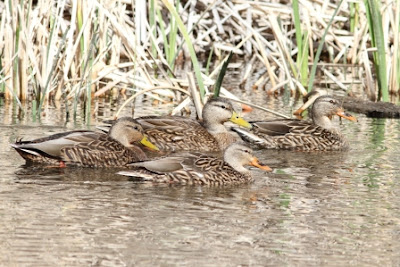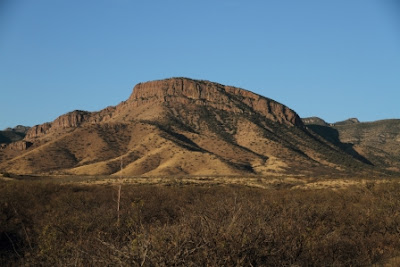We reached the western New Mexico border then went south to the Chihuahua Mountains and the village of Portal, just north of the Mexican border. We had a mission: to see the Mexican Chickadee, Yellow-eyed Junco, and the Elegant Trogon. This southern range is the only area in the U.S. to see these three birds. For the Elegant Trogon, it is early in the season, but there was a small chance we could luck out. Highway 80 was narrow and the turn-off to Portal was narrower still.
We were through the tiny village of Portal before we knew we had entered it and continued up the winding canyon road to the Stewart Campground. This is a well know birding location but it was early in the season and we were the only RV in the campground. We spent a quiet and cool evening in this pristine and isolated location. Emma insisted I sleep with bear spray close at hand.
Feb 21
We were awake early and drove up the canyon to the nearby research station run by the American Museum of Natural History. Just around the corner was the Sunny Flats Campground where everyone else was camping. Who knew!!
The research station was under renovation so we went for a short hike in the area. As hoped for, we spotted a Yellow-eyed Junco. If you want to see this junco north of the Mexican border, then you have to come to this mountain in south-east Arizona. When we saw the Junco, we both agreed he looked a bit demonic.
To get to the next birding spot we had to park the RV and ride our bikes up the dirt road beside Cave Creek. We locked up the bikes and went for a pleasant walk up Cave Creek Canyon. We hiked into the pine forest and saw Bridled Titmouse, Mexican Jays and White-breasted Nuthatches. Unfortunately, we did not see a Mexican Chickadee. It was a treat to enjoy this natural beauty in silence. We saw two people on our whole trek. The only noise was the Mexican Jays who like to follow people and serenade them on their way.
White-tailed Deer
We startled a family of White-tailed Deer that was seeking shade and water under a small bridge. One deer (perhaps the mother) waited in the wide open river bed, for the other deer to "get with the program" and high tail it to cover. This deer made itself very vulnerable, but it refused to leave without its companions. We waited and hid, and the deer ventured back to their spot. On the way back, we drove slow and stopped at the village of Portal. There were a few seed feeders but it was too early in the season for hummingbird feeders. The birds were elsewhere except for a busy Acorn Woodpecker looking in his holes for the last of the acorns he had stored away for the winter.
We stopped for a snack by the Arizona / New Mexico State Line Road. There were a few Vesper Sparrows (181) in the grass and shrubs by the roadside.
We drove to Deming, New Mexico for the night. Gotta love the camping rates at Walmart!
February 22
The high, flat Chihuahua desert stretched out before us as we headed east. The desert land is like a high prairie with a few islands of protruding hills. The vegetation is so sparse that no raptors were seen soaring or perching anywhere along the way.
We crossed the continental divide but you wouldn't know it if not for the sign. The entire desert was at 4,600 feet and appeared completely flat. After a few hours we approached the Rio Grande river at
Las Cruces.
Emma camped at a Starbucks to complete grants and work tasks on the internet and I went birding at the state park beside the Rio Grande River. I was excited to see it then in shock when I did. The Rio Grande was an absolute trickle. It is dammed further upstream and only a tiny dribble is allowed through.
Rio Grande River at Las Cruces, New Mexico
The farmers need all the water for irrigation. The river cannot supply enough water so they sink deeper wells which have further lowered the water table. Without periodic floods, the traditional willows and cottonwoods along the banks have withered and died.
We drove on to El Paso, Texas. For miles we drove through the urban sprawl of this dry, dirty city. No one seems to care about the litter that accumulates along the highway. The rest stops and highway maintenance are privatized. At one rest stop, a grandmother and her four-year-old granddaughter were shocked to see that the restrooms were locked. The little girl was desperate to go, and unlike B.C., there are no tall trees to hide behind. Emma let them use our RV washroom, and the two were so happy and relieved (pun intended). After getting lost on the freeways a couple of times we found Highway 180 and headed east toward the Guadalupe Mountains.
You feel like you are driving on the top of the world when you go through the west Texas prairie. We stopped at the town of Cornudas for the night.
This place would make Corner Gas look like a metropolis. There was one restaurant and a couple of houses. The people were very friendly and the food was good but life here was hard. All of the potable water had to be trucked in from El Paso.
February 23
We woke up to see flocks of sparrows outside out RV kitchen window. A faucet was slowly dripping and the sparrows were fighting for access to the water. There were dozens of Brewer's Sparrows mingling about and waiting for a chance at the water.
They were being chased off by large sparrows. These birds were difficult to identify but we were able to study them at close range through the RV window.When we went outside they would fly off so I photographed them through the window for ID purposes.
Finally, the ID came together. We were looking at Lark Buntings (182) in winter plumage. In mating plumage, it's an easy call as the males would be jet black with white wing bars, not so in the winter.
Lark Bunting in winter plumage beside a smaller Brewer's Sparrow
The Texas wind was really picking up as it started to blow at a steady 80 kms an hour. We hit the road and headed for the Guadalupe pass before it got any worse. The earlier signs that warned of the potential for zero visibility really started to hit home. On the plus side, the wind was blowing from directly behind us. I took my foot completely off the gas and put the RV in neutral. We continued to sail along for miles at a steady 80 km on the flat desert terrain.
As we reached the pass to the Guadalupe Mountains, the road up the pass turned 90 degrees. Oh boy, now the wind was hitting us broadside. The steady 80 km wind was not over the top, but the 100+ gusts were troubling. It felt like an extra pair of hands kept trying to grab the wheel and steer us into the ditch.
We stopped briefly at the visitors centre at Guadalupe Mountain National Park. Given that the roads were soon to be closed due to the wind, this was not the day for a hike, so we saddled up and headed over the pass to Carlsbad Caverns National Park.
The wind continued from behind and we made good time to Carlsbad Caverns. This is a world heritage site and Jim has wanted to come here since he was 10 years old and his best friend lorded it over him that he had been there and Jim had not. Words and pictures cannot describe the grandeur of the caverns. They are over 750 feet deep and miles long. There is a great self-guided walking tour of the cavern that describes the history, geology and stewardship of the caverns.
We walked down the natural entrance which took an hour then spent another hour walking around the caverns big room.
A Magical Place
Outside the visitors centre we saw a Sage Thrush (183) then drove into the city of Carlsbad for the night. It was quite the day with wind storms and underground adventures.



















































